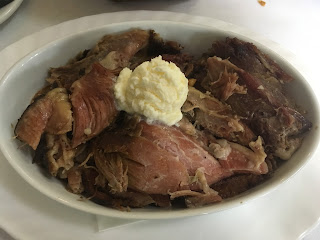Given my love of cooking, one of my favorite parts of living in a new culture is learning about the local cuisine. In Serbia, it mostly boils down to meat and cheese, though it's not quite that simple.
Kaymack, a cornerstone of most Serbian meals, is a cream cheese-esque spread that melts like butter and adds the perfect flavor to just about everything. From meats, to bread, or even crepes, everything tastes better with kaymack.
My roommates and I have been on something of a culinary tour while here since eating out is genuinely affordable. Some of our favorites have included Zavičaj, which is home to my favorite plijescavica and breakfast bowl, and
Sesir Moj (This Hat of Mine) which we discovered today.
Sesir Moj is located in Skadarlija, one of Belgrade's oldest neighborhoods. With its cobblestone streets, charmingly-odd street signs, and abundance of flowers, it is also one of the most charming.
 |
| Note: vertical sign reads "moon" |
The food was unbelievable- while the menu gave away little regarding what we were actually ordering, we were not disappointed (though to be fair we rarely are here).
I ordered a roast pork knuckle that came with "domestic cream cheese" which is how kaymack is often translated. The dish was relatively simple, a pork knuckle roasted atop potatoes seasoned with paprika and topped with kaymack, but in this case, simple was exactly what it needed to be- it is the single most flavorful pork dish I have ever eaten.
My two roommates ordered a dish that they were warned would be spicy, though we've come to learn that Serbs find bell peppers spicy so we take that warning with a grain of salt nowadays. Surprise, surprise, their dish featured sautéed bell peppers and onions, mixed with roast pork and a light sauce, topped with- you guessed it- kaymack.
We also split a Serbian salad- tomatoes (paradajz, pronounced "paradise" in Serbian), cucumbers, sweet onions, and usually topped with cheese. Admittedly this is fairly ambiguous to the region, but it brings me a certain sense of comfort as it reminds me of all the various "tomato and ______" salads I ate growing up in an Italian family.
For dessert we did our usual, choosing an item at random to see what we ended up with as english translations of desserts are rarely accurate- the Serbian names are no more helpful: in Serbian crepes are called palachinke, or pancakes, because they chose the wrong word to translate (fun fact this was one of the first pieces of food advice I received in Belgrade).
We ended up with an "apple pie" which was more akin to baklava, but delicious nonetheless.
Exploring Serbian food has been one of my favorite weekend pastimes these past few months, but I've also enjoyed experiencing food from other cultures- Spain, Italy, and so on- in Belgrade. The mostly-joking rule of thumb in this city is that everything is about 85% what you expect it to be- the rain is mostly on time, though may be an hour late one day, or you order an iced coffee and get served three scoops of ice cream in a latte. I was recommended a "diner" by a coworker and as a New Yorker am desperate to try it and see what Serbia thinks a diner should be like. Updates to come!



















































